Top 4 Most Terrifying Pirates Who Voyaged The Seas
October 23, 2018
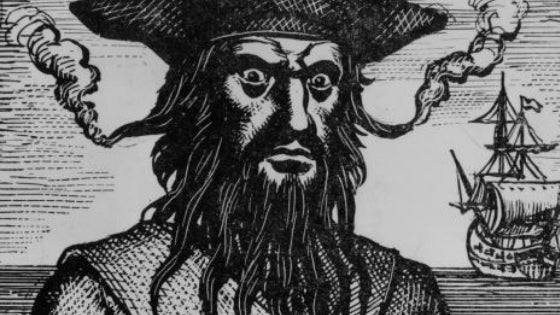
For years, we have imagined pirates as scary men with an eye patch, wooden leg, and striped black and white pants. Add to that the sword, a pet parrot, and golden earring, and you have yourself a perfect picture right out of an R. L. Stevenson novel.
The thing is, if you look into the pirate lore, you’ll realize these swashbuckling rulers of the seven seas were a lot more than just your average Captain Jack Sparrow.
What’s interesting is that some of the most terrifying pirates were known to have been women as well as men.
These pirates were notoriously known as violent thieves who murdered, tortured, stole, and captured ships and sailors.
Although piracy began as early as 319 B.C., it still exists to this very day.
The most terrifying pirates were known to have raided the seas during the Golden Age of Piracy, between 1690 to 1730.
They sailed the Atlantic and Pacific Oceans and the Caribbean. Some of these terrifying pirates included Blackbeard, Calico Jack, Anne Boony, and Madame Cheng.
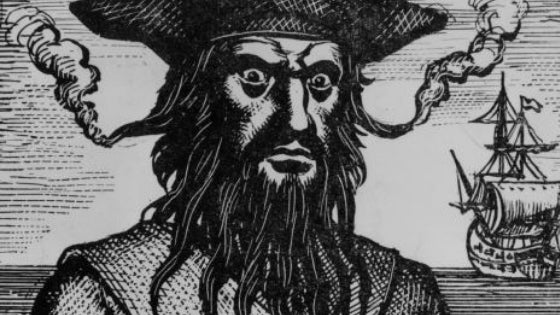
The Terrifying Pirate Blackbeard
One of the most terrifying pirates to ever sail the seven seas was England-born Captain Edward Teach – or Thatch.
Commonly known as Blackbeard, a nickname acquired from his long black beard, which covered most of his face.
He struck terror in the hearts of all who happened to have the misfortune of coming across him.
He braided his beard in separate tails and intimidated enemies by boarding their ships in a cloud of smoke — apparently, he coiled smoking fuses on the braids and slung guns, pistols, and daggers across his chest.
Edward Teach was known to have sailed mainly around the West Indies and the Northern American colonies.
Not much is known about his past. He may well have started as a sailor on British privateer ships to attack French and Spanish vessels during the war.
In late 1717, Blackbeard captured a French merchant vessel or slave ship and renamed it the Queens Anne’s Revenge.
He equipped it with over 40 cannons, guns, and firepower. That was the launching point of his piracy. He was known to be the worst and cruelest pirate to sail the seas.
One of the most famous acts of piracy was the Blockade of Charles Town, in South Carolina. He stopped all ships from entering or leaving the port.
Additionally, Blackbeard ransacked any vessel that attempted to sail past him.
One of the ships had a member of the Council of South Carolina on board, so Blackbeard took him and some of the passengers as prisoners.
He asked for a large supply of medicine. Teach’s demands were met and the prisoners were released.
Teach was killed, and his piracy ended, on November 22, 1718, during a battle with Lieutenant Maynard at Ocracoke Island.
The most terrifying pirate was shot 5 times, stabbed 20 times, and finally, his corpse was thrown in the water while his head was attached to Lieutenant Maynard's bowsprit so he could get a reward.
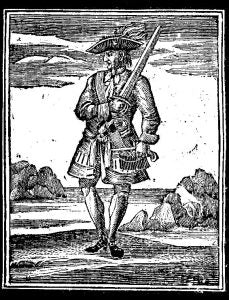
The Jolly Roger and Calico Jack
John Rackham was another terrifying pirate who roved the Caribbean seas, mainly the Bahamas and Cuba.
His nickname, Calico Jack, was due to the calico colorful clothing that he wore.
He was an English pirate, born in 1682, and was known for his design of the Jolly Roger flag, and for having two female pirates, Anne Bonny and Mary Read, as part of his crew.
His piracy records began in 1718 as a quartermaster on Charles Vane’s sloop Ranger.
Vane, Calico Jack, and the crew were known to have robbed and terrorized ships.
In late 1718, they encountered Man-of-war, a large French ship full of many goods. The ship attacked Vane’s sloop and he decided to pull back from the battle since it was twice the size of the Ranger.
Calico Jack was against Vane’s decision and wanted to fight the French ship, partly for its valuable goods and partly for want of a much larger ship when captured.
The majority of the crew supported Calico Jack and voted to remove Vane from captaincy, and named him a coward. They then made Calico Jack captain.
He continued to terrorize and capture numerous small ships in the Caribbean, and a year later he captured The Kingston; this was a big ship full of rich cargo.
The conquest was witnessed by many merchants and Governor Rogers, who became furious and sent bounty hunters to capture Calico Jack.
The hunters caught them, yet they succeeded in escaping.
Later on, they returned to the Bahamas and asked the Governor for a royal pardon.
They claimed that Vane forced them to become pirates. Governor Rogers believed them and granted them the pardon.
During his stay in the Bahamas, Rackham began an affair with Anne Bonny, the wife of James Bonny. James Bonny was a sailor working for Governor Roger.
When he found out about the affair, he charged Anne, who was later convicted of adultery.
Anne Bonny and Calico Jack escaped, and once again, pirated the Caribbean. They settled in Cuba so that Bonny could give birth to Rackham’s child.
In Cuba, they met Mary Read, who was the second female to join Rackham’s crew.
In 1720, at Bry Harbour Bay in Jamaica, Rackham and his crew were captured by Jonathan Barnet.
Calico Jack was tried, convicted, and hung in Port Royal, Jamaica, while Mary Read and Anne Bonny were given a temporary stay as they claimed to be pregnant.
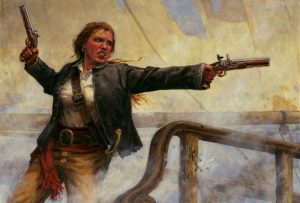
The Fiery Anne Bonny
Anne Bonny was an Irish/American pirate born around the 1700s near Cork, Ireland.
She was the illegitimate child of an Irish lawyer, William Cormac, and Mary Brennan, one of the maids working in his household.
Cormac separated from his wife and moved to London to escape his wife’s family after they discovered his infidelity.
He took custody of Anne, yet when his wife found out, she refrained from giving him money and allowance.
Cormac began losing clients because of the scandal, so he immigrated with Mary Brennan and Anne to South Carolina. He attempted to establish a law business but without success.
Instead, he established a merchant business to make ends meet. The business was profitable, and as a result, he was able to invest in both a house and a plantation.
At the age of 13, Anne’s mother died of typhoid fever. From then on, the redhead had to fend for herself most of the time and was known for a ferocious and daring temper.
There are claims that she stabbed a girl with a knife and beat a man to death when he forced himself on her.
William Cormac tried to marry his daughter off to a local, but she refused. Instead, she married James Bonny, a poor sailor. Her father disapproved and kicked her out of the house.
Anne and James left to live in the Bahamas where he worked as a sailor for Governor Rogers, but Anne was unhappy in her marriage.
When she met Calico Jack, her life took quite an unexpected turn.
In 1720, she was convicted of adultery and she escaped with Calico Jack. They spent a few years pirating and capturing ships in the Caribbean.
It was thought to be bad luck to have women on ships, however, Bonny’s fierce character swayed Calico Jack’s decision.
During battles, she disguised herself as a man and fought with her crew. When Calico Jack and his crew were captured by Jonathan Barnet, Bonny was also found guilty and sentenced to death.
However, her pregnancy saved her from execution.
There are claims that Anne Bonny’s father paid a ransom for her and she was released from prison.
Apparently, she returned to South Carolina, where she remarried and had several children.
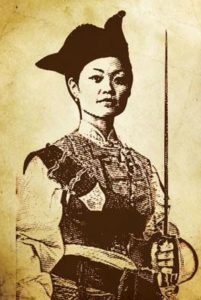
The Chinese Terror, Madame Cheng
One of the most terrifying pirates who terrorized the Chinese sea, was Madame Cheng.
She was born as Shi Yang in 1775, and started her career as a Chinese Prostitute. In 1801, she married a famous pirate, Cheng I.
His family was known for successful pirating with a profound criminal record. He commanded a pirate fleet of around 400 ships and 50,000 men.
After they married, Madame Cheng adopted Cheng I’s son, Chang Pao and she also gave birth to two more sons, Cheng Ying Shi and Cheng Xiong Shi.
A few years after their marriage, Cheng I died and Madame Cheng took over the Red Flag Fleet.
With the help of Chang Pao, her adopted son and lover, she expanded the terrifying pirate fleet to 1800 ships and around 80,000 sailors. He became her second in command and lieutenant of the fleet.
She united her fleet and issued a code of laws. The code was strictly enforced and included the beheading of anyone who disobeyed superiors or stole from villagers who supplied the pirates with their needs.
Additionally, any goods taken as booty had to be registered and presented for inspection prior to redistribution.
In addition to the code of laws, Madame Cheng had rules for female captives. Pirates often married the pretty captives, and when married, they had to be faithful.
The unattractive females were either released or ransomed. If pirates raped their captives, they were beheaded.
Punishment for violating the code included whipping, chopping ears off, and clapping in irons.
The Red Fleet encompassed the most terrifying pirates, and the government tried to destroy them but failed to do so.
Madame Cheng’s fleet started facing a few defeats that were ignited by the Portuguese Navy. She realized that she would not be able to sustain these defeats.
In 1810, Madame Cheng asked for and gained pardon from the Chinese authorities. She then married her adopted son Chang Pao and gave birth to his son.
After Chang Pao died in 1822, she moved back to her hometown and opened a gambling house and brothel.
Pirates Galore!
The most terrifying pirates during the Golden Age, were known to have raided and roved the seas.
They sailed oceans and removed themselves from civilized society.
Although pictured with a stereotypical image of the wooden leg and eye patch; they were from every race, color and gender.
They were a unique bunch with harsh and vicious dreams, without homes, yet full of courage and bravery.
Violence and murder was their known career, and death awaited them every day and in every battle.
Be sure to check out the Pirates Week Festival of the Cayman Islands and indulge yourself in some extra-ordinary swashbuckling experiences!
